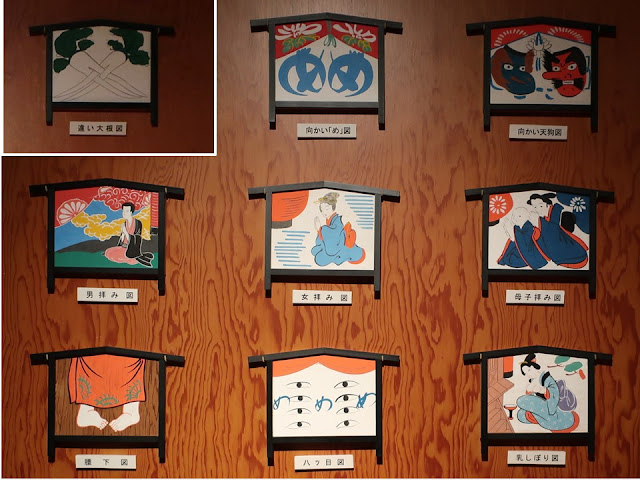Theme 4:
Modernization and the Opening of Yokohama's Port
【テーマ4】横浜開港と近代化
The cannon in the mid-19th century welcomes us. It was installed in Shinagawa (Tokyo) to protect Edo from US fleet.
開港以降の横浜の展示は大砲の展示から始まります。1853年、ペリーの再来港に備えて品川台場に据え付けられたということです。
日本人は異人を恐れていました。ペリーをはじめ様々な将軍を想像した絵が出回りました。
1854年の二度目の来港は、蒸気船三隻、帆船三隻の艦隊で現れました。米国は貿易と鯨油を取るための捕鯨基地が必要だったのです。
Documents below were kept by American women who traveled around the world in 1887.
She stayed at Yokohama Grand Hotel, and visited Nikko, Hakone, Ise, Kyoto and so on. She collected arts such as a sword, then left Japan from Nagasaki.
The world tour was popular among wealthy Western people, but it was only 35 years since foreigners were approved to land on Japan. Steamers developed new entertainment which was cruising.
(upper left: map of Yokohama in English, menu in English, lower: travel guidelines of Kanagawa prefectural government)
1887年、世界一周旅行で日本に立ち寄ったアメリカ人女性が集めた資料。横浜グランドホテルに滞在し、日光、箱根、伊勢、京都などを廻り刀などの美術品を購入して長崎から旅立ったそうです。
欧米の富裕層は、世界一周旅行がブームであったといいます。ペリー艦隊の来港から35年を経て、艦船でしか行けなかった航海が、レジャーになっています。蒸気船のおかげ。
神奈川県の史料は「帝国内地旅行外国人心得」。左上は横浜の英語地図、右上はレストランの英語メニューです。
Russian (1861): It says “To satisfy Japanese people’s curiosity about the mysterious outsiders, Edo publishers scrambled to send ukiyoe(picture) artists to depict new foreign residents.”
外国人に興味津々の日本人は、浮世絵師に外国人を描かせました。魯西亜人(おろしやじん、一川芳員、1861年)
Theme 5: Contemporary Kanagawa and
Traditional Culture
【テーマ5】民俗「現代の神奈川と伝統文化」
There are rich exhibits in a folklore
room. 充実した民俗展示室
Weakening Ties in Folk Society、薄れゆく村人たちの絆
It is written as follows; Rural tasks such as rice-planting,
rethatching, and road mending used to be very hard because of manual work. People
shared these jobs, and it strengthened their bond. They also organized
systems to held wedding or funeral, to hold festivals, and kou (religious group) for example
Inari-kou and Ooyama-kou.
However, the development of agricultural and construction
machines, plus urbanization transformed village life.
The Bon rite of Kanagawa is particular. People make sand bases (30-40 cm square and 20-30 cm height) and offer incense sticks, flowers and so on in order to welcome and send off ancestors’ spirits.
神奈川県独特のお盆の風習、砂盛り。13日に30~40cm四方、高さ20~30cmに砂を盛って、線香を立て花などを供え、その傍らで送り火や迎え火を焚きます。
Full scale farmer’s house (Living room and dining room)、実物大の農家(居間といろり端)
It says, “Irori served as the source of heating and lighting,
and as a stove for cooking. Since family members gathered around the irori, it was
a symbol of home as well. Keeping the fire burning in the irori symbolized
prolonged prosperity of the household.”
In the case of wedding or funeral, people removed partitions to make
a large hall. Around the 1960s, such dwellings started to disappear, together with
thatched roof houses.
Moon viewing setting was exhibited when I visited in September. It says that children went around neighborhood and were given the offering (dumplings).
訪問時は月見飾りのセッティング。子どもたちはお供えをもらって歩いたといいます。
Udon noodle breakfast at a mountain village in Sagamihara
山村の朝飯(相模原市佐野川)
Dinner: one dish and rice were added to the breakfast menu.
山村の夕飯。朝飯にご飯とおかず一品が追加。うどんが多いし、うどんとご飯を食べるのは関西の習慣だと思っていたので意外でした。
 Typical family members and a layout of
their house around mid-twentieth century: there is no Irori here, because its role was divided to a living room and a kitchen.
Typical family members and a layout of
their house around mid-twentieth century: there is no Irori here, because its role was divided to a living room and a kitchen. 昭和中期の家の様子。家族と間取り。囲炉裏の機能は居間と台所に分けられた。
Livelihoods (agriculture) and rites、なりわいと儀礼
It says, “Until about the mid-1950s, agriculture was dominated by
the whims of nature much more than it is today. Farmers believed that
guardian deities gave them good crops. They held various rituals while
cultivating to celebrate planting, harvesting, and to preventing insect damages
etc.”
Praying for a rich harvest: people stand a pole when they start planting rice and pray a rich harvest, preventing insect and storm damage.
五穀豊穣祈願:田植えの水口祝いのため、嵐除け、虫除けを願って立てる。
Three bundles of rice seedlings (left): After the rice planting, people offered this to Koujin god and appreciated successful job. They had a good dinner in the evening and celebrate. Dinner after planting (right)
左:田植えの終了を感謝し、三把の苗を荒神様に供える三把苗。各家々では、晩飯にご馳走を作って祝った。荒神苗ともいうらしい。 右:田植えの終了の祝い膳
Mushiokuri (Rituals for getting rid of
insects)、虫送り
It
is written, “It was an important ritual like pray for rain. In many cases,
dolls made out of straw which possessed by insect sprits, mounted on horses.
The procession of such dolls marches to the beat of drums to a throw point on
the border of the village at evening.”
稲に害を及ぼす虫を追い払う虫送りは、雨乞いと同様に重要な共同祈願だったという。藁人形を虫の精に見立て、村境まで送り出す。伊勢原では、神前でイナゴ祓いをした後、夜に入ってから松明をつけ、馬に藁人形を乗せて神の旗を立て、法螺貝を吹き、鉦や太鼓を鳴らしながら遠くの山に虫送りしたという。
Small emas (copy) which are wooden boards to offer to a shrine or a temple: those show people’s prayers. Chigai-daikon (radish) for good marital relations (upper left), Yatsume (eight eyes) for eye disease (lower center), secret prayers and so on. We can understand people’s worries.
小絵馬(複製): 小絵馬は庶民の素朴な願いを表している。違い大根は夫婦円満、八つ目は眼病平癒、人に言えない悩みは拝み絵馬ということで、女拝み図や男拝み図などがあると書かれています。思いが伝わります。
It is written, “It is considered that these o-fuda talismans have psychic powers, so people enshrine them. Small omamoris (lower left) are portable.”
「御札には神仏の霊力が宿っているとみなされ、御札を祀った。大型なお札に対し、お守りは携帯用の小型なものであった」と書かれています。
Various folklore events、様々な民俗行事
Omihime-sama: children in Miura enshrine these objects. They bathe objects in Bon (summer) and renew the clothes in the New Year’s Day. Then they bring them to the next house. Children have a party when they perform it. It is a lovely event.
The Gion-boat is floated off-shore of Kanazawa and people return to the port without seeing the boat. It is a summer event to prevent misfortune and plague.
祇園舟は、金沢区富岡八幡宮の夏の行事で、厄神・疫病退散を願うそうです。祇園舟を、神舟に移し、沖合で放棄して、後ろを見ずに陸に戻ります。
The head of this object is a horse and the body is a turtle. People float it on the sea. It is also a summer event to prevent unhappiness.
こちらは、本牧神社の夏の神事で、首は馬、胴は亀の作り物を海に流し、厄神退散を願います。
This event is held in February. People eat and drink in front of a hanging scroll of Inari god.
二月の初午に開かれ、稲荷を祀る掛軸をかけ、御神酒、小豆飯、煮しめなどで共同飲食をします。
Events and local crafts、行事と民芸品
Sagami puppet show: these shows were held in the fourteen places in the Edo period (1603~1868). Five groups continue these performances even now. This is traditional fun of villagers.
相模人形芝居:江戸時代には14カ所に人形芝居がありました。現在では、五座が公演を続けているということです。村人たちの楽しみですね。
The last area of folklore exhibits local crafts. These are thirty-six wooden egg suite, which is a Japanese version of a matryoshka doll.
民俗の最後のコーナーは民芸品。組子細工の三六卵。これは、日本版のマトリョーシカです。
Ooyama spinning tops are popular souvenir of Ooyama shrine.
大山独楽は大山詣りの人気のお土産です。
Outside of this museum is a new downtown “Minato-mirai district”.
外は、近代的な「みなとみらい地区」です。
Five funs(楽fun)were found. Visited in October, 2019
Website: http://ch.kanagawa-museum.jp/english
http://ch.kanagawa-museum.jp/
(much info in Japanese), accessed in July, 2020
Previous post:
Kanagawa Prefectural Museum of Cultural History (part1)、神奈川県立歴史博物館(1)
Next post (Museums
in the same area):
Historical Museums in Yokohama、横浜の歴史資料館








































Comments
Post a Comment